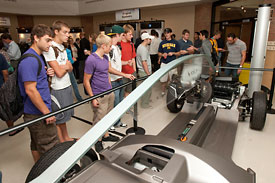Engineers from General Motors and the university have joined forces to reinvent the automobile, and the Detroit automaker also hopes to enlist future U-M graduates in the ambitious effort, a top GM official said during a recent visit to the Ann Arbor campus.
Inspiring U-M students to pursue careers in automotive engineering is one of the goals behind a GM/U-M new-technology exhibit that opened Sept. 9 at the Duderstadt Gallery on the North Campus, said Thomas Stephens, vice chairman of global product development for General Motors. Stephens attended a reception on the opening day of the exhibit, which runs through Sept. 17.
“We want to get the students excited so they want to be part of it, because this is the opportunity of a lifetime,” Stephens said as he stood beside the chassis of a Chevrolet Volt, the battery-powered, plug-in vehicle scheduled to go on sale next year. A leaner General Motors recently emerged from bankruptcy proceedings and will focus much of its efforts on building more energy-efficient vehicles.

“We now have labor and operating costs that are very competitive, I’ve got a balance sheet that’s been totally cleaned up, and now what we have to do is make the world’s best cars and trucks,” Stephens said. “What better place to work?”
The Duderstadt exhibit is sponsored by the GM/U-M Institute of Automotive Research and Education, which was formed in May. The institute, which builds on more than 50 years of collaborations between the organizations, brings together four GM-funded College of Engineering labs. Each lab focuses on a set of technologies that will be critical to next-generation vehicles: advanced batteries, engine systems, smart materials and vehicle manufacturing.
“Placing the four labs in a single institute gives the whole endeavor more coherence,” said David Munson, the Robert J. Vlasic Dean of Engineering. “It helps us achieve a more integrated view of the vehicle we’re trying to create for the future.”
Projects underway at each of the four labs are displayed at the Duderstadt exhibit. There’s a sleek, black Cadillac CTS that’s part of a project to incorporate smart materials — substances that can sense changes in the environment and respond to them — into new vehicles.
“We’re heading into a future filled with unknowns, and the University of Michigan is well-positioned to provide General Motors with the technical solutions and the engineering talent it will need,” said Diann Brei, director of the Smart Materials and Structures Laboratory.
Against one wall of the exhibit room is a 400-pound, T-shaped Volt battery pack that contains more than 200 lithium-ion battery cells. Shawn Lee, a doctoral student at the Advanced Vehicle Manufacturing lab, said the university is helping General Motors to redesign the Volt battery pack to reduce costs while delivering improved battery performance.
“The U-M is helping to design the next-generation battery pack for the Chevrolet Volt, and it’s exciting to be a part of that,” Lee said.
That’s the kind of feeling that exhibit organizers hope to instill in other U-M students.
“An exhibit like this can be a real motivator,” said Ann Marie Sastry, co-director of the GM/U-M Advanced Battery Coalition for Drivetrains. “What I want students to see is that the automotive area has become reinvigorated, and that this is an opportunity to work on really interesting problems.”

